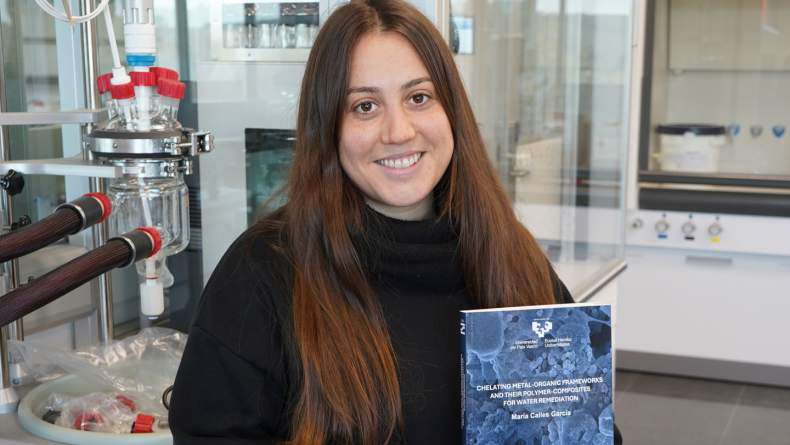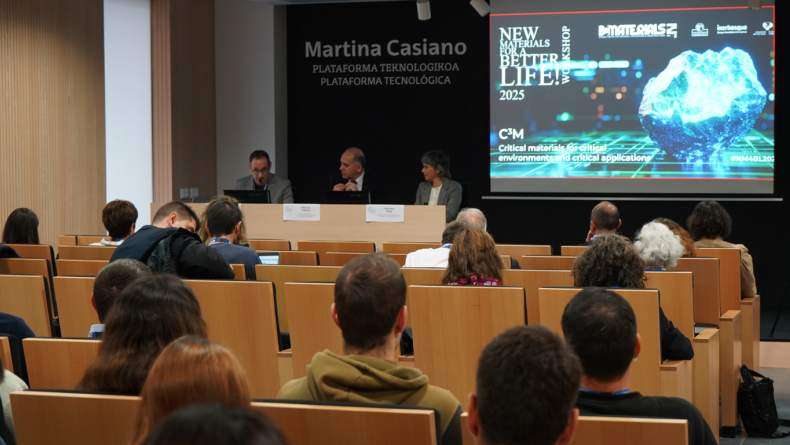BCMaterials Fortnightly Seminar #71: Laura Gracia, David Gandía y Paula González

LAURA GRACIA
(BCMATERIALS)
Preparation of Au/TiO2 nanostructures for incorporation in photoanodes of high efficiency solar cells
Nowadays, the need for the introduction of renewable energies has led to solar power as a significant alternative. Although silicon solar panels dominate now the market, its disadvantages –such as its price, high stiffness, danger of its production– have led to different alternatives. One of them is the DSSCs (Dye Sensitized Solar Cells), cheaper and easier to process than silicon solar panels. In recent years, surface plasmon resonance of metal nanoparticles has been regarded as an attractive approach to boost the performance of semiconductor nanostructured-based light-harvesting assemblies. In the present work, different types of TiO2 nanoparticles (NPs) with anatase structure have been synthesized and, then, Au NPs have been obtained following different chemical methods to be incorporated onto the TiO2 NPs. These nanostructures will be used as photoanode for DSSCs.DAVID GANDÍA
(BCMATERIALS)
Respuesta magnética de bacterias magnetotácticas alineadas
Magnetotactic bacteria (MTB) are a diverse group of microorganisms with the ability to orient and migrate along the geomagnetic field. This unique feat is based on the synthesis of intracellular organelles, magnetosomes, ferrimagnetic crystals surrounded by a lipid membrane and organized into chains inside the bacteria. The bacteria synthesize these nanoparticles from the iron that they find in their environment. Thanks to the cultivation of new strains and the development of new techniques to manipulate them, researchers from different laboratories have made significant progress in clarifying the molecular, biochemical, chemical, genetic and physical bases of the formation of magnetosomes and how these unique nanoparticles work.
In this master thesis we take a new step in this research field by carrying out a thorough study of the magnetic response of these bacteria when they are aligned. This has provided us with a deeper knowledge and understanding of the magnetic properties of organized magnetotactic bacteria in general, and on the magnetic behavior of their chain of magnetosomes in particular.
In order to achieve the alignment of bacteria we have employed two different approaches. First we have tried to create 2D assembles of aligned magnetotactic bacteria deposited onto a silicon wafer; and then we have also created 3D assembles by immersing them in agar solution. Magnetic measurements carried out in these systems clearly indicate that we have been able to obtain a good alignment of the bacteria and that their magnetic response changes drastically depending on the orientation with respect to the applied magnetic field.
In order to better understand these results, we have carried out numerical simulations using a Stoner-Wohlfarth model that considers a single uniaxial anisotropy for each bacteria assuming a 1D chain of magnetosomes. Our model indicates that a single uniaxial anisotropy cannot fully reproduce the magnetic response of the chain, and that the magnetic response of the chain is more complex than a 1D magnetic dipole.
The results obtained in 3D are better than in 2D and suggest that the uniaxial anisotropy model must be adjusted to a more complex model that takes into account the emergence of new anisotropy axes.
PAULA GONZÁLEZ
(BCMATERIALS)
Development of proton exchange membranes based in polymer@ionic liquid composites
Ionic liquids (IL), liquid salts at room temperature are being explored in different applications due to their good properties such as high chemical and thermal stability, high ion conductivity or non volatility. IL can be combined with a wide variety of polymers for the production of solid membranes which combine the good mechanical properties of the polymeric materials with the properties of the ionic liquids previously mentioned. One of the most interesting applications of these composites is the development of proton exchange membranes (PEM) with high proton conductivity in dry and wet states, good mechanical strength and thermal stability.
This work focuses on the development of polymer@ionic liquid membranes using different types of ionic liquids. In particular, the study was focused on the use of PVDF-HFP and three different protic ionic liquids ([dema][TfO], [MIm][NTf2] and [MIm][Cl]). The membranes were synthesized under different conditions and posteriorly characterized by several techniques (SEM, contact angle, mechanical tests, TGA, FTIR and electrical measurements) in order to compare the properties of the membranes with the different ionic liquids and select the most appropriate for specific applications. From the results it has been seen how aspects such as morphology, hydrophobicity, conductivity or mechanical properties change depending on the synthesis procedure employed and on the type of ionic liquid used, as well as the amount of this.
Related news
María Calles, nueva doctora de BCMaterials
Queremos felicitar a María Calles García por haber obtenido su doctorado en Ciencia y Tecnología de Materiales por la UPV/EHU. El 4 de diciembre María realizó una brillante defensa de su tesis...Charla invitada con investigadores del Instituto de Microelectrónica de Barcelona (3 de diciembre)
El próximo 3 de diciembre, a partir de las 12:00 en el auditorio Martina Casiano de Leioa, BCMaterials recibirá a los investigadores titulares del Instituto de Microelectrónica de Barcelona (IMB-CNM...Charla invitada con Liu Yao sobre baterías de metal-litio (2 de diciembre)
El próximo lunes 2 de diciembre, Liu Yao, profesor del Shanghai Institute of Applied Physics presentará una charla invitada en BCMaterials titulada ‘Li Metal Batteries: From Liquid to Solid-State’....Éxito del workshop anual de BCMaterials, dedicado a materiales críticos
La exitosa edición 2025 del workshop anual de BCMaterials reunió el pasado 19 de noviembre en Leioa a un centenar de asistentes para examinar el estado del arte y debatir sobre los materiales...



